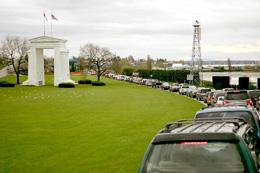Canada stops ‘flagpoling’ at land border crossings

By Mata Press Service
The option for foreign nationals to secure a Post Graduate Work Permit (PGWP) at the border between the U.S. and Canada has been removed, Immigration Minister Marc Miller has announced.
The decision targets the practice of "flagpoling," where certain temporary residents momentarily exit and re-enter Canada to sidestep the usual waiting period for permit approvals through online applications.
Miller said that handling "flagpolers" diverts critical resources from border officers' primary duties—upholding the safety, security, and economic well-being of both nations.
Immigration, Refugees, and Citizenship Canada (IRCC) has recently curtailed flagpoling hours at 12 key entry points to better manage the influx of travellers during peak times and concentrate on higher-priority tasks such as addressing high-risk travellers and facilitating trade.
IRCC aims to encourage temporary residents to pursue work permits within Canada and has taken measures to accelerate the processing of domestic applications.
Enhancements include streamlining online application procedures and allowing workers to commence employment with a new employer immediately, without waiting for the processing of a new work permit.
“The ability for workers to begin new employment immediately without waiting for new work permits to be processed is a positive change.” said Charanjit Kaur, an immigration consultant from Iconic Immigration.
From March 1, 2023, to February 29, 2024, PGWP applicants represented about one fifth of the foreign nationals who attempted to flagpole, IRCC said.
“While we continue to support and recognize the contributions of international graduates to Canada’s labour market, ‘flagpoling’ is unnecessary. The time and effort required to process applications from ‘flagpolers’ takes officers on both sides of the border away from their crucial role in protecting the safety, security and prosperity of Canadians and Americans. This measure will help prevent this practice while maintaining the integrity of our immigration system,” said Miller.
Dominic LeBlanc, Minister of Public Safety, Democratic Institutions and Intergovernmental Affairs said Flagpoling places an undue burden on our border services officers.
“With this change, we’re taking a measured approach to combating the issue and putting an even greater focus on maintaining the integrity of our shared border with the United States,” he said
Other recent measures to address flagpoling have included:
• speeding up processing times for in-Canada work permit applications,
・ simplifying online application forms and processes so foreign nationals can continue working while they wait for a decision on their new application, and
・ authorizing workers to start working for a new employer right away, rather than waiting to have their new work permit application processed before changing jobs
Last week’s announcement by Miller comes in the wake of a push by U.S. Senate Majority Leader Charles Schumer calling on the Canadian government to crack down on the use of ‘flagpoling’.
Schumer said as summer comes border officials fear it could only get worse, which is why he is calling on Canada to stop this practice to ensure tourism can continue to flow smoothly between countries.
"Every year, families look forward to visiting beautiful Niagara Falls and rely on a smooth trip between Canada & the U.S., but this loophole is causing unnecessary delays at Rainbow Bridge, Peace Bridge and other crossings across New York. This practice is holding up travellers, impeding traffic flow, hindering trade, and causing increased wait times to make the short trip to Canada from Buffalo,” said Schumer.
With more and more Canadians using this practice to avoid paperwork delays, flagpoling has become a huge problem that’s exacerbating lines for passport checks, standstill traffic, and frustrating visitors travelling to Niagara Falls with their children, he said.
Schumer explained that in January of this year alone, nearly 2,000 Canadians engaged in flagpoling, randomly showing up at Western New York bridges. In January, over 700 instances of flagpoling occurred at the Rainbow Bridge, over 560 at Peace Bridge, and over 420 at Lewiston Bridge.
According to border protection officials, they fear that given current trends 2024 could be the highest year for flagpoling yet, with 12,000 claims already processed just this year across the border and nearly 25,000 claims processed in 2023.
Each year, thousands of people flagpole at Canadian entry points and since 2021, there has been a year-over-year increase, according to Canadian Border Services Agency (CBSA) statistics shared with Global News.
This year alone, a total of 32,410 people have flagpoled, as of June 2.
Last year, 61,561 used this service, which represented a 90 percent jump from 2022 when 32,394 people flagpoled at the U.S.-Canada borders.
In 2021, flagpoling dipped by 34 percent as non-essential travel across the U.S.-Canada border was restricted amid the COVID-19 pandemic.
The 12 Canada-US border checkpoints that will see their flagpoling limited services are:
- Armstrong, Quebec
- Fort Erie (Peace Bridge), Ontario
- Saint Armand/Philipsburg, Quebec
- Saint Bernard-de-Lacolle, Quebec
- Stanstead Route 55, Quebec
- Aldergrove, Pacific Region
- Douglas, Pacific Region
- Niagara Falls Rainbow Bridge, Ontario
- Queenston-Lewiston Bridge, Ontario
- Pacific Highway, Pacific Region
- Boundary Bay, Pacific Region
- Abbotsford-Huntingdon, Pacific Region
According to the CBSA’s official website, flagpoling is a viable alternative to accessing online immigration services.
However, the office warns that those going for this approach may face long lineups and their turn to access services may not come before the end of service hours.
“We highly recommend you use IRCC’s online services.”









